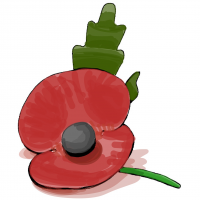
The Royal British Legion makes a fortune out of me. Every year I must buy at least 10 poppies to replace the previous poppy that I’ve lost, ripped, crushed, dropped food over, sat on, eaten—but I suppose that this is one instance when my incessant clumsiness is a good thing.
I must always buy a poppy. We must all always buy a poppy, because it takes absolutely nothing to put a pound in a box and pin a little paper flower to our coats. All right, we may stab ourselves in the chest several times or rip our fingers to shreds fiddling about with the silly little pin, but it’s not much.
I don’t know why, but every year I worry that Remembrance Day will be a bit smaller, a bit less prominent; as though, as time goes on, it little by little loses significance. But of course it never does. If anything, it seems to get bigger.
I tend to take my cue from television newsreaders: as soon as they start wearing their poppies, normally around the end of October, I know it’s time, and I go on the hunt for poppy sellers. Gradually, streets are awash with little bobbing poppies on coats and jackets, shop dummies wear them, cars and lorries stick huge poppies on their front grills; I even saw a dog with a big poppy attached to its collar. There was an app on Facebook this year that put a poppy in the corner of your profile picture. I never worked out how to do it, but plenty of other people obviously did as little red flowers sprang up on pictures all over the place.
I didn’t make it to the Remembrance Sunday service at the war memorial on Ewell Road, due to the fact I was working in Kingston (and, running late, managed to obliviously bulldoze straight through the middle of the Kingston Remembrance parade by their war memorial, about which I was mortified and very apologetic), but I have been before and the crowd it draws is wonderful. There are people of every age: brothers, sisters, mothers, fathers, grandparents, grandchildren and children of lost or fighting loved ones, and also people with no link to its meaning other than an appreciation of what has been and is being done for us. What always touches me is the sight of little children, sitting in their parents’ arms, poppy pinned to their coats, being gently explained the importance of Remembrance Day. They don’t know why they are there or what’s going on, but their parents will gradually teach them, and hopefully one day they will understand.
If I could, I would show every child in the way I was shown. When I was 14, my school took our year on a history trip to Belgium to visit the World War 1 cemeteries and battlefields. Our year was notoriously ‘lively’—pretty much 180 Bash Street kids—and our two coaches were full of excited girls mucking about and being a bit unruly. But as the coaches drove through the bleak Belgian countryside on a grey, freezing March afternoon, I remember the laughter and chatter gradually slipping into quiet; and when the row, upon row, upon row of white gravestones appeared, curving gracefully round the domed memorial of Tyne Cot Cemetery, there was silence. The coaches stopped and 180 girls stepped off and drifted into the cemetery. Tight-knit groups parted, best friends went separate ways; every one of us sank into our own overwhelming realisation of what we’d been reading about and not really understanding in textbooks in our classrooms. The sight of nearly 12,000 graves—8,300 of which are unnamed—was all we needed to teach us.
So since then I have always worn a poppy and I always will. Whatever the reason for wearing one, whatever the reason for standing in the cold by a memorial—it is enough. We can never honour what was, and what still is, in any other meaningful way. As long as we wear that little red flower, and go and stand out in the cold, and stop talking for just two minutes of our lives, we will always be saying what we so desperately need to say: thank you, thank you, thank you.










Comments
Post new comment